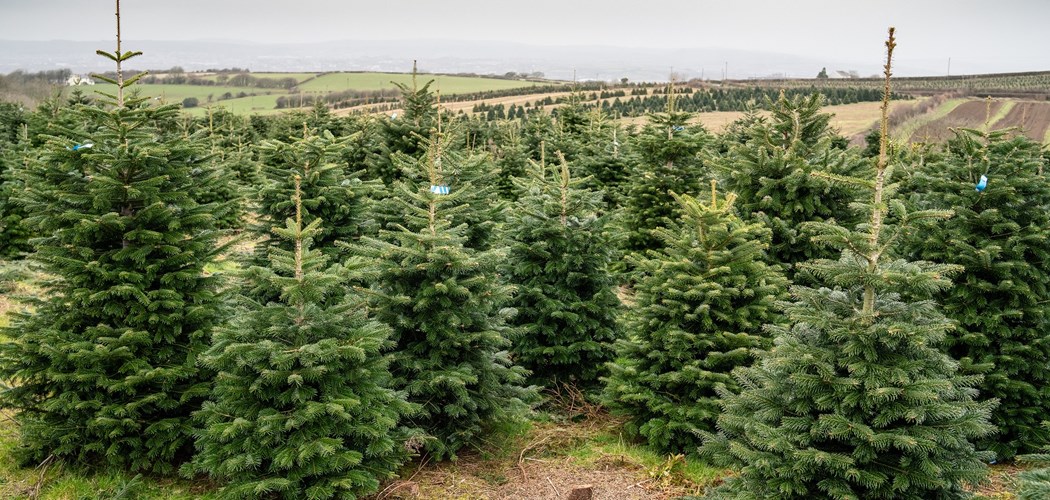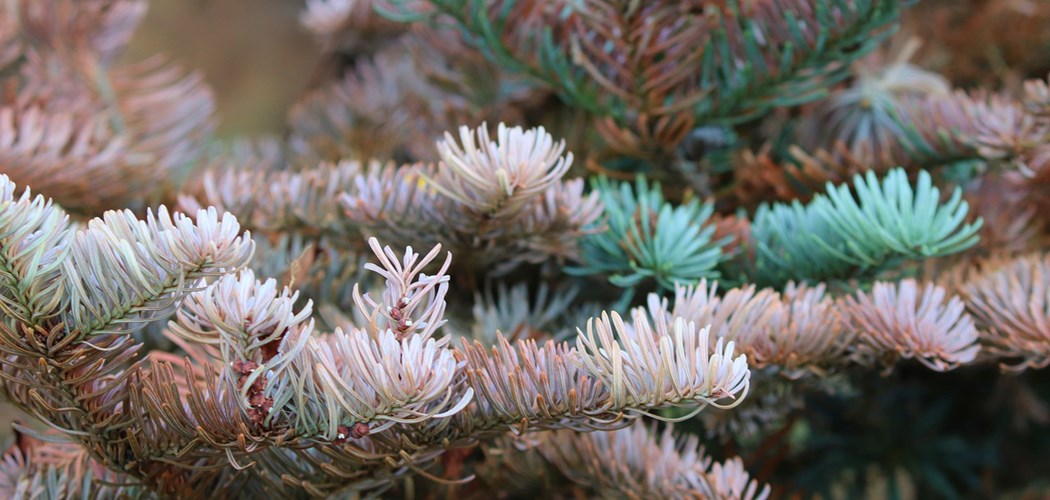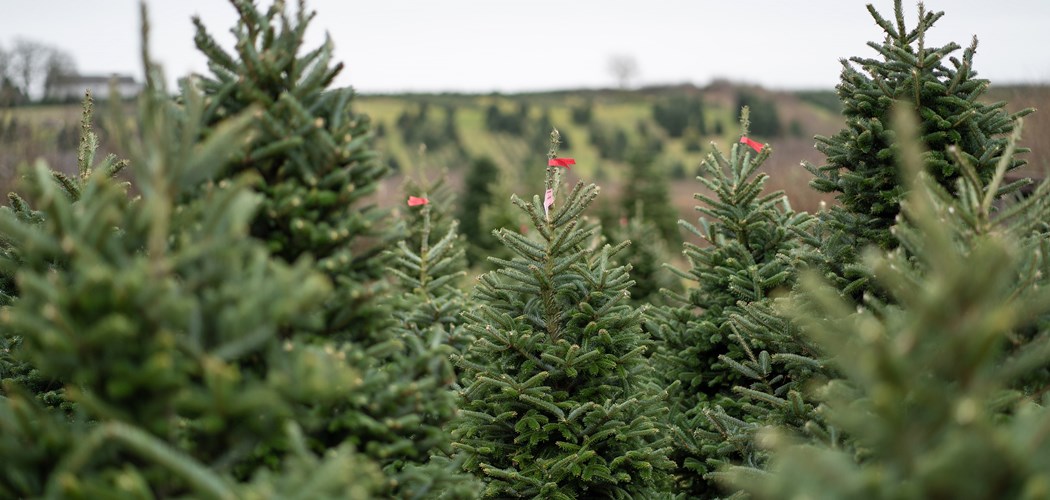Technical Advice Sheet: Christmas Tree – July

Download the Toolkit: Christmas Trees - July 20 - English.pdf
See the extract below and download the full technical advice sheet at the bottom of the page.
Mites
You should regularly check your trees for mite damage every 7 – 14 days, although wetter weather in Wales may reduce mite damage. Conifer spinning mite has been a particular problem in the south east. Eggs overwinter and hatch in the early spring, with juveniles feeding on the first flush. These reproduce rapidly, and so progress through several generations in a year although these are generally only active in summer and autumn. These feed on sap by puncturing through the cuticle, leaving surface damage which is a rusty colour and leaving the needles at risk of dehydration in hot, dry weather increasing the risk of premature needle drop.
The range of specific acaricides to use for the control of conifer spinning mite is now limited to the use of spirodiclofen (Envidor) EAMU (which will early next year no longer available in UK) and clofentezine (Apollo 50SC) EAMU. Both acaricides are active against summer generation eggs (but not overwintering eggs) and very early motile stage (just emerged from egg) mites. Another acaricide new to the UK (a METI with activity against all stages of CSM) may shortly be available for use in outdoor hardy nursery stock (EAMU) including Christmas trees, acequinocyl (Kanemite), but this is unlikely to be until at the earliest 2021.
Aphids
Giant Fir Aphid (Cinaria confinis) a pest of true firs predominantly Nordman and Noble fir, in recent years has become an increasing problem in the run up to Christmas, particularly if customers for trees require pesticides to be applied no later than September. As the adult and juvenile aphids feed under the branches or through the bark on the main stems of trees this aphid can produce honey dew, but more important is the damage it’s feeding can cause when present in large numbers Large to the internal tissues that can lead to depressed patches and to scars on the wood in later.
Although naturally occurring predators insects such as ladybirds, lacewings and hover flies can provide control of giant fir aphid, often infestations occur early or very late in the year when these predators are inactive, or the numbers of aphids in specific areas of a plantation may be so high that bio-control is unlikely to provide sufficiently quickly affective control without some damage to the trees occurring.
Caterpillars
Light brown apple moth (LBAM) is a widespread pest of fruit and woody nursery crop plants throughout most of the UK including Scotland. A serious pest in the USA initially affecting Douglas fir grown as Christmas trees about five years ago, it started to be noticed as a pest of especially Nordman but now also Fraser firs in the UK.
Diseases
Current Season Needle Necrosis in Nordman and Noble Fir can be exacerbated by adverse weather conditions during the early part of tree growth, it is now recognised that the symptoms displayed by affected needles on current seasons shoot growth is produced by a fungal infection in the tree. CSNN tends to be less of an issue where the trees being grown are late flushing trees and when the spring weather at the onset of flushing is cool or warm but most importantly dry. The disease is generally most severe when the weather is hot and humid and rainfall occurs at the early stage of tree growth and tends to develop most seriously where following rain the young needles of trees dry slowly.
The first symptom observed are a distinct orange/brown scorch marks on the upper surface of needles, this rapidly develops into orange/brown and grey brown bands across the needle lamina, later with black spores protruding from the stomata of the underside the necrotic section needles. Affected needles usually drop in late July through till September i.e. leaving in some cases a high proportion of the current seasons new shoot growth devoid of needles. Badly affected trees are inevitably unsaleable even if left for several years in an attempt to permit them to recover. Although some fungicides in laboratory trials have exhibited activity against the fungus Sydowia polyspora none so far have proved to provide reliable control under commercial field growing conditions.
Weeds
Weeds are now becoming an issue in young and established plantings of Christmas trees, recent rain has produced rapid germination and then growth of a wide range of annual weeds in young plantations. In addition perennial broad leaved and grass weeds have also been stimulated to grow flower and seed. All early-season residual herbicides will have by now broken down in the soil. In most cases and especially young trees where their annual growth has been completed, weed removal can be delayed until the use in the late summer or early autumn of an overall glyphosate. As you don’t need to at aim in the case of young trees for completely bare ground as low-level weed cover can be protective from hot, dry winds and risk of solar damage in the mid and late summer.
This is a good time to consider your plans for planting next year, choosing sites that are free of horsetail, perennial bindweeds or large populations of other perennial weeds. If you are planting on arable sites avoid those that have previously been used to grow linseed or oil seed rape as these will carry significant risk of volunteers in the following season. Also avoid sites where annual of biennial grass weeds known to be resistant to the majority of graminicides have built up e.g. black grass. For existing plantations look at current weed populations to help you plan what applications to use later in the year and in the spring. Diflufenican i.e. Hurricane SC and or glyphosate e.g. Roundup (only some products are permitted for application overall Christmas trees e.g. have EAMUs or on label approval), can be used later in the year, and at the same time or later in the autumn residual herbicides can be applied for pre and in some cases post emergence control of late autumn and winter germinating annual weed.
Disclaimer
Every effort is made to ensure the accuracy of information and recommendations given in these notes. All applications of crop protection chemicals should be made in accordance with label recommendations, which should be consulted before spraying. Some of the pesticides mentioned in these notes may not be supported by label recommendations for their use on Christmas tree but are permissible via Extension of Authorisation for Minor Use (EAMU) in the UK under ‘The Revised Long Term Arrangements For Extension Of Use (2002)’. In these cases, the use of the pesticide is at the risk of the user and Tyfu Cymru does not accept liability for any loss or damage caused by such use. The references to on-label approvals and EAMUs for use of pesticides in Christmas trees and are correct at the time of writing. These are subject to change and approval may be withdrawn at any point. It is the grower's responsibility to check approvals before use of pesticides. If in doubt a grower should seek advice from a BASIS qualified advisor - this is available free of charge for eligible growers through the Tyfu Cymru program, please contact us to arrange an appointment – email/telephone advice is also available.
Related Pages
Christmas Tree Network Study Visit: Technical Pruning Notes
Timings of pruning can vary between tree types. For Nordmann Fir pruning should be made in spring or summer as sap flow will be sufficient to help the trees recover, whilst Spruce should be cut in the autumn or winter. It is best practice to aim to o…
9/16/2021 2:32:43 PMTechnical Advice Sheet: Christmas Tree Needle Diseases
A range of similar, but subtly different, foliar diseases can impact Christmas tree plantations. Careful management of both the crop and growing area can be useful in controlling risk factors.
8/2/2021 11:39:28 AMWebinar: Christmas Trees - Summer Update (Current Disease issues)
In this Session Janet Allen (ADAS) focused on current disease issues in Christmas trees. Particularly looking at current season necrosis, fire weed rust and Rhizosphaera needle cast, alongside some specific weed and pest control issues.
6/18/2021 3:21:40 PMPests and Disease: Threats, Diagnosis and Reporting
It is essential that pests and diseases are identified correctly before they can be controlled efficiently and their spread prevented. In this presentation Dr Ana Perez-Sierra, Head of Tree Health Diagnostic and Advisory Service will describe the pro…
11/26/2020 2:07:16 PM


